Despite the fact that some people are afraid of them, spiders are a natural part of a healthy ecosystem. In fact, having spiders around is a good thing! It leads to people being bothered by fewer pest insects, including the famous and dreaded Florida mosquito.
Most spiders are completely harmless when it comes to humans. Only two potentially dangerous spiders can be found in Florida and even they rarely bite people.
We’ll discuss twenty of the most common spiders you’ll come into contact with in Florida, let you know how they hunt, and tell you how dangerous they are.

Share This Image On Your Site
<a href="https://outforia.com/florida-spiders/"><img style="width:100%;" src="https://outforia.com/wp-content/uploads/2022/03/Florida-spiders-infographics-03162022.jpg"></a><br>Florida Spiders Infographic by <a href="https://outforia.com">Outforia</a>You May Also Like: These Are The Sharks In Florida That You Should Know About with Photos, Infographics, Facts, and more!
20 Spiders Found In Florida
1. Widow Spiders
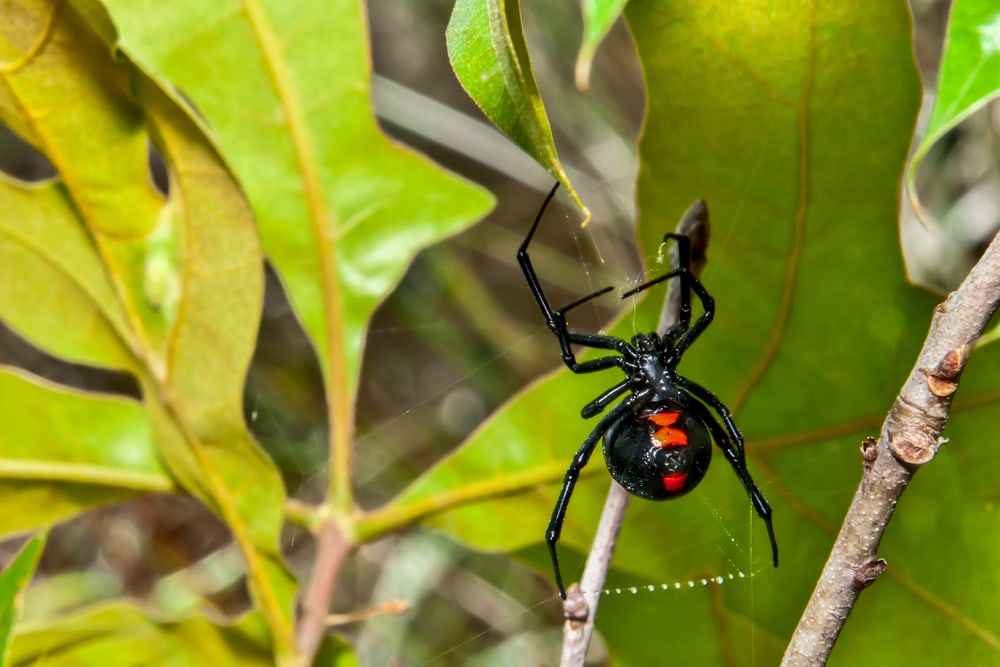
Three widow species are native to Florida, with a fourth being accidentally introduced. Southern black widows, Northern black widows, red widows, and brown widows (introduced) can all be found in the Sunshine State.
Widow spiders typically share similar color patterns and markings. Generally, they have shiny black abdomens and red markings, but widows can also be pale or have lateral stripes. Most females range from 8 to 15 millimeters (0.8 cm to 1.5 cm), while males can be as small as 2 millimeters (0.2 cm).
Widow spiders tend to prefer dark, confined spaces. In nature, they tend to hide under rocks or logs, but widow spiders adapt easily to urban environments and can be found in outbuildings or other manmade structures. They build conical webs in the corners they hide in.
Venom from widow spiders can affect people differently. For some, they may experience mild symptoms, but for others, the symptoms can be severe. The bites are generally not fatal for adults but can cause nausea, difficulty breathing, burning pain, and body shakes.
2. Recluse Spiders

Recluse spiders are not native to Florida, but they have been observed throughout the state and are known to establish small populations in scattered locations. Three species of recluse have been seen in Florida, including the brown recluse, Mediterranean recluse, and Chilean recluse.
Brown recluse spiders tend to have a dark violin-shaped marking on their abdomen. While they tend to be brown in color, both thor marking and overall color can vary drastically. The surest way to identify a recluse spider is by their eyes. They have only six eyes, arranged in three pairs on their face. They average around 6 mm (1 inch) in body length.
Like widow spiders, recluses tend to love dark areas. They are especially common in firewood piles and hide under logs and rocks in natural environments. Populations can be found in single buildings within Florida, but they have no known stable populations.
Recluse bites have a necrotic effect that can damage tissue surrounding the bite location. They can go unnoticed until symptoms appear, as the bites themselves are nearly painless. Rarely can a bite result in death, but serious skin damage, nausea, and muscle pain can occur.
3. Orb Weaver Spiders

Orb-weaver spiders get their names from the spiral-shaped webs they build. Many of them tend to build a new web every day, consuming the old web and then resting for an hour or two before constructing the new one.
Multiple species of orb spiders can be found in Florida including:
- Starbellied Orb Weaver
- Spinybacked Orb Weaver
- Lined Orbweaver
- Arrow-Shaped Orbweaver
- Arabesque Orb Weaver
- Spotted Orb Weaver
- Red-femured Spotted Orbweaver
- Shamrock Spider
Many orb-weavers have very distinct shapes and color patterns.
The star-bellied orb-weaver for example has a large, crown-shaped abdomen. Most of their body is an orangish color and they’re easy to distinguish from other spiders.
Spinybacked orb-weavers have six distinct points on their abdomens and can be a wide variety of colors. Their legs and spines tend to be black with white, orange, or yellow coloring on their backs.
Arrow-shaped orb-weavers have abdomens shaped like flint arrowheads. The spines are black and red, with a big yellow abdomen, a red underside, and an orange head and legs.
While their bite can be painful or cause discomfort, orb-weaver spiders are not considered a threat to humans. They’re commonly found in yards and gardens and are great to have around because they eat nuisance insects.
4. Crab Spiders

Crab spiders get their name from the way they look and how they sit. Instead of spinning webs, these crabs hide in opportunistic locations and ambush their prey. Most often, they wait with their front legs pulled back, helping make them look like crabs.
Look for a few species of crab spiders in Florida, including:
- Deadly Ground Crab Spider
- Ground Crab Spider
- Flower Crab Spider
- Running Crab Spider
Crab spiders aren’t considered dangerous for humans or their pets. For the most part, they lie in wait for small insects, seizing them with their legs and then paralyzing them with a venom that does little to larger creatures.
5. Silver Garden Spider

Many garden spiders are a type of common orb-weaver, but like with all scientific classification, some families are considered separate. This includes the Argiope family of garden spiders.
Silver garden spiders have a silver or white head and abdomen, with several orange, black, and yellow spines. Their legs are usually orange, with dark-colored bands on them. Average females have a body size around 0.5 inches (12 mm), with males almost always being the smaller gender.
The light colors on the silver garden spider reflect UV light similar to the way flowers do. This is thought to confuse butterflies and other pollinators into flying into the spider’s web, thinking the spider itself is a flower.
6. Black and Yellow Garden Spider

Another member of the Argiope family, the black and yellow garden spider is one of the most uniquely-colored spiders in the world. The head is white or silver, the abdomen has a thick black stripe, and the sides have yellow patches. Its legs are yellow or orange close to the body and have thickening black bands as they get to the ends.
These spiders have a criss-cross pattern at the center of their web, which is usually the place you’ll find them sitting. The body length for a female spider is usually around one inch (25 mm).
Just like the silver garden spider, bites for humans are not dangerous and produce little more than some localized pain and swelling.
7. Red-Spotted Ant Mimic Spider
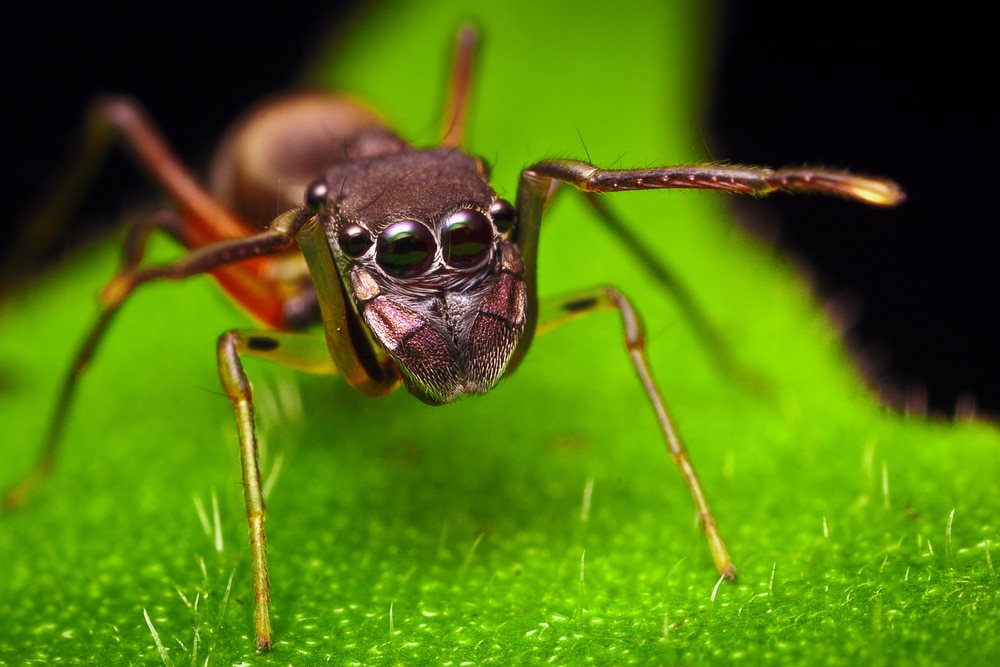
Red-spotted ant mimic spiders (Ant mimics for sake of brevity) get their name from the fact that they look similar to ants and often mimic their behavior to get close enough to attack. Instead of building a web, these spiders actively hunt for their food.
As a hairless, black spider with red marking, they can sometimes be confused for black widows. Females grow to around half an inch (13 mm).
Their behavior is interesting because they commonly walk with their front two legs held up, seemingly mimicking antennae. They target small insects and only use their silk to wrap eggs or build a nest.
8. Fishing Spider

Fishing spiders are semi-aquatic and most often found feeling for vibrations in the water. They tend to be large spiders and all three species Are some shade of brown with white markings. Females can grow up to 4 inches (102 mm), making them one of the largest spiders in the United States.
Fishing spiders use their webs to tie their eggs underneath them, not to hunt. They sit on top of the water or at the water’s edge and use their legs to feel for the vibrations of tiny fish and insects in the water. They then snatch their prey and paralyze them with mild venom.
9. Woodlouse Spider

Woodlouse spiders are named as because their primary prey is woodlice. Females can grow up to 0.6 inches (15 mm), while males only grow to around two-thirds that size. They have long legs and long fangs, and their overall color is reddish-brown.
Woodlouse spiders are active hunters and don’t use webs to capture prey. They mainly come out at night in areas with woodlice presence. Their bite can be painful, however, it isn’t dangerous for humans or pets.
10. Gray House Spider

Gray house spiders are shy and will usually remain completely hidden away from people. They are mostly gray or black with very short legs and their abdomens are covered in hair. The abdomen hair is mostly black with white or gray spots and their legs are black with dark bands.
Adult females reach a size of around 0.6 inches (15 mm). They’re called house spiders because they commonly build their webs inside human-made structures. They tend to stay tucked away in a secluded portion of their web and only come out when they’ve caught a small insect to eat.
11. Orchard Spider

Orchard spiders are a colorful type of orb-weaver, with a mostly silver and white body. They have colorful markings that can range from green, yellow, black, orange, or pink. Their head is a light, almost translucent green color.
Adult females grow to a body length of around 5/16 of an inch (7 mm). They’re commonly found in and around fruit trees and other crops that attract small insects. Like other orb-weavers, their bite is not dangerous to humans or pets.
12. Wolf Spider
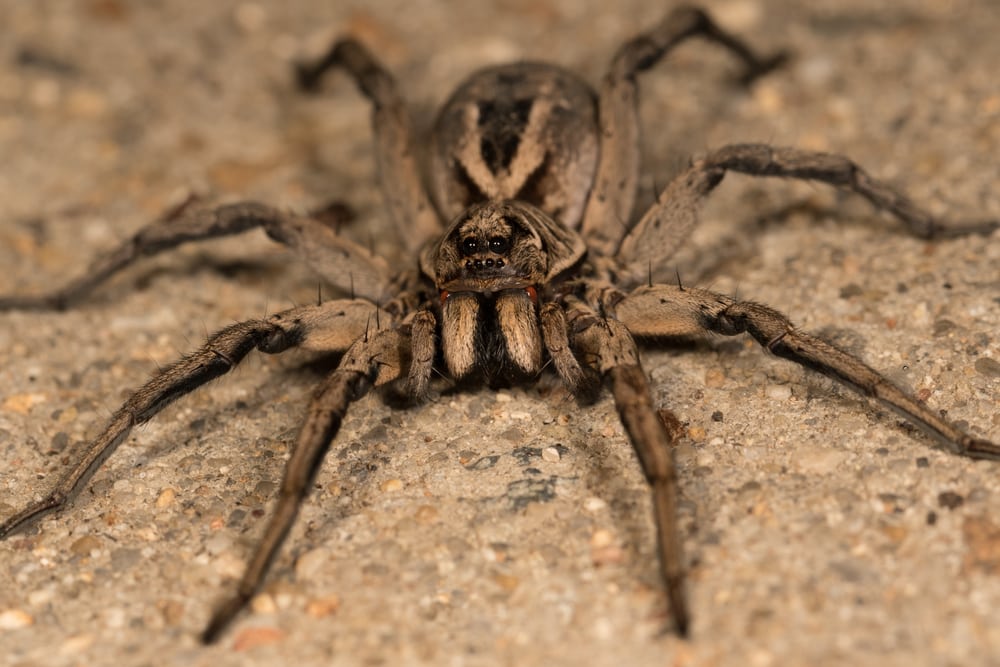
Wolf spiders are a large family of big hunting spiders found throughout North America. Most wolf spiders look very similar, with two rows of four eyes, thick legs made for walking, and a brown coloration with black markings.
Some species can grow to as large as three inches (76 mm) including the legs. They’re commonly seen running through grass patches in search of small insects to pounce on. While not life-threatening, wolf spider bites can cause skin damage, intense pain, and sometimes swollen lymph nodes.
13. Magnolia Green Jumper
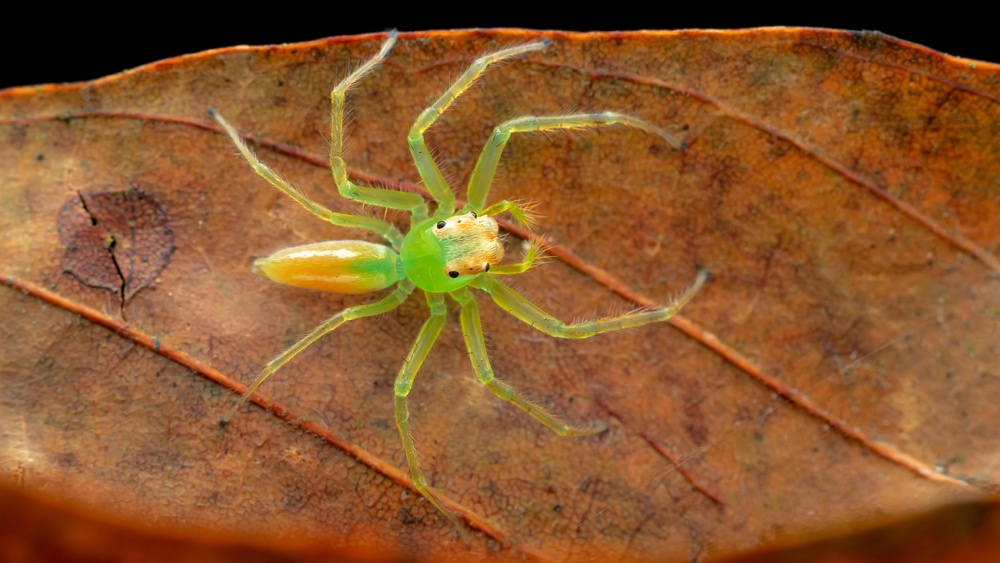
Green jumping spiders are tiny, even when compared to other jumping spiders. Adult females grow to around 0.3 inches (0.8 cm), with adult males of course being smaller. Green jumping spiders have mostly green and almost translucent bodies with a yellow or orange patch around their eyes.
Like other jumping spiders, they’re able to launch themselves after prey, to escape, or to reach new areas. They don’t spin webs, instead, they chase down tiny insects like aphids to eat. They’re usually shy and run instead of bite when afraid, but even if they do bite they aren’t dangerous.
14. Dimorphic Jumper
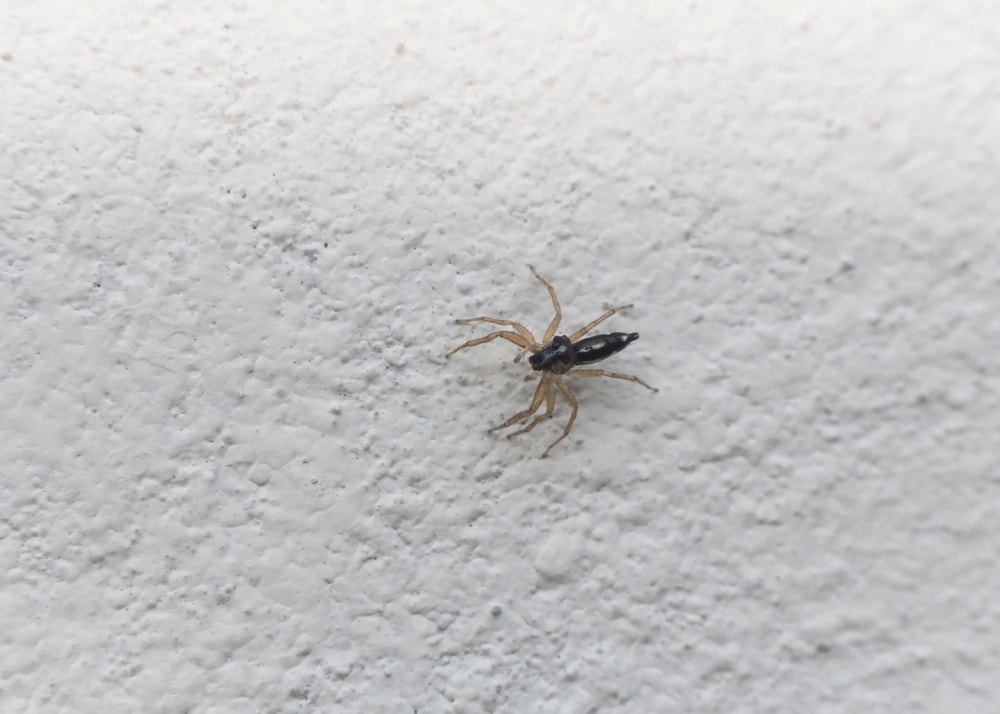
Dimorphic jumpers get their name from the fact that there are two types of males in the species that have different appearances and behaviors. The dark morph has a completely black body with white legs while the gray morph has gray or white stripes all over its body. Females have a brown body and legs with white or red markings.
Females grow to a length of around 0.2-0.3 inches (0.5-1.0 cm). They use their silk as safety lines to avoid dangerous falls while jumping. They aren’t dangerous to humans, feasting on tiny insects instead.
15. Gray Wall Jumper

Gray wall jumping spiders are covered in thin hairs that can be a range of gray shades. They usually have two black stripes on their carapace and abdomen and black rings on all of their legs. Adult females reach body lengths around 1/2 inch (1.2 cm), while males are almost always smaller.
Like other jumping spiders, they don’t build webs with their silk. They can set an anchor line to catch them if they fail a jump though, making jumping spiders very tiny bungee jumpers. They almost always jump away from people and almost never bite, but even if they do, their bite is not dangerous to people.
16. Trap-Door Spider

Trap-door spiders are a genus of spiders with a unique nesting behavior. They dig burrows into the ground and secure the entrance with a trap-door. When prey triggers the silk threads near the door, these spiders pounce from their burrows and pull prey into the nest.
Spiders in the family average a body length of around 1 inch (2.5 cm). They can be a dark brown or red color and usually have shiny heads. They can run very quickly and almost always flee to their burrows when people come around. While mildly painful, their bite is not dangerous.
17. Banana Spider

Banana spiders are unique orb-weavers native to Central America. They have a long, oblong shape and are mostly yellow, hence the name banana spider. They have long black legs and their heads can have markings that almost look like skulls.
Female banana spiders reach sizes between 1 inch to 2 inches (25 to 50 mm), but males are much smaller, coming in at around 0.2 inches (6 mm) long. Their webs can be up to six feet (2 meters) across, making it easier for the banana spider to catch flying insects.
Banana spider bites are only about as painful as a bee sting, but they are not considered dangerous spiders.
18. Spitting Spider

Spitting spiders have a unique hunting strategy where they capture and paralyze prey by shooting venomous silk threads from their head. They’re very easy to identify, with a light brown or tan body and distinctive darker markings. Their body shape usually looks like two spheres stuck together.
Adult females grow to sizes around 0.15-0.25 inches (4-6 mm), but males are slightly smaller. Their silk glands are located on the underside of their abdomen and their head. The head glands allow them to spit silk at prey and incorporate a sticky venom that paralyzes the prey. Neither the venomous silk nor its bite is dangerous for humans.
19. Daddy-Long-Legs

Also known as cellular spiders, these are often mistaken as types of mosquitos or harvestmen insects. They have incredibly tiny bodies, but very long legs of up to two inches (51 mm). They’re actually the culprits for some cobwebs, as they have very thin silk and weave webs in corners, nooks, and crannies of structures.
One myth about these strange-shaped spiders is that they’re the most venomous spider on the planet but their fangs are too small to penetrate human skin. They actually can bite, it’s just rare. Their venom is incredibly weak and poses no threat to humans.
20. Common House Spider

Common house spiders are some of the most common spiders throughout the world. They make their nests in human structures, but they do so out of the way in basements, closets, or attics. They’re one of only a few spiders that can cohabitate, or build nests in groups.
Adults can grow to have a one-inch body (2.5 cm) if you include the legs. They tend to be a dull brown color and can have darkened splotches on the body. They have long, thin, and banded legs.
You May Also Like: Learn About These Wild Monkeys in Florida and How They Got There with Photos, Infographics, Facts, and more!
Benefits of Having Spiders Around

Spiders are a natural part of a healthy ecosystem. While they get a bad reputation and most people are likely to try and rid their homes and properties of them, spiders are actually a great thing to have around.
Mosquitos are awful in Florida. I can tell you from personal experience that sometimes in the summertime if you walk outside for thirty seconds you come in with two or three bites. Lovebug mating season results in car windshields being plastered with the poor things too.
Spiders of every species you’ll find in Florida naturally feed on these kinds of pest insects. Even if they aren’t eating hundreds or thousands of insects, their webs trap and kill more than enough to make a difference.
Spiders also help stop the spread of diseases. Fleas, roaches, and flies are all on the menu for the friendly jumping spider in your house. In reality, squishing the spiders you see in your home only makes it easier for pests to survive.
If you have a phobia or just don’t want spiders inside, try capturing them and putting them outside instead of killing them. Of course, dangerously venomous spiders need removal as it isn’t safe to leave them in your home. Consult a pest removal service if they become too much of a problem.
You may also like: Learn the 35 Different Types of Scorpions and Where You Can Find Them: WIth Images, Facts, and More!
FAQ

Are all spiders venomous?
Almost every species of spider on the planet is venomous. Spiders use their venom to paralyze their prey and it’s a very important part of their hunting repertoire. Thankfully though, very few spiders possess venom that’s dangerous to people. Most spider bites end up looking like a normal insect bite, with a raised area of puffy and itchy skin.
Some spiders do pose a significant risk to humans including brown recluses, black widows, tarantulas, and a couple of others. There aren’t many fatalities due to spider bites though, mostly due to the venom’s slow spread and the excellent antivenoms people have developed for just such occasions.
Why do spiders curl up when they die?
Like other insects, spiders are invertebrates. They have a hard outer shell called an exoskeleton in place of interior bones. Some people might be surprised to know that they also have no muscles in their legs either!
Spiders move their legs by changing the pressure in the lower sections, essentially moving them by extending flexor muscles by pushing fluid in and out of those leg sections. They maintain the pressure with their heartbeats, just like how humans have blood pressure in their veins.
When a spider dies, the heart no longer pumps. This means their legs are no longer pressurized and instead return to a curled-up state. That’s the real reason spiders curl into a ball when they die.
You May also like:
Discover different species found in Florida here:

Wild Monkeys In Florida | Poisonous Frogs In Florida | Anoles In Florida | Birds Of Florida | Vultures In Florida | Woodpeckers In Florida | Hawks In Florida | Florida Freshwater Fish | Florida Frogs | Scorpions In Florida | Geckos In Florida | Alligators In Texas | Sharks in Florida | Largest Alligator In Florida | Beach Birds Of Florida | Snakes In Florida | Florida Turtles | Owls In Florida | Lizards In Florida |









